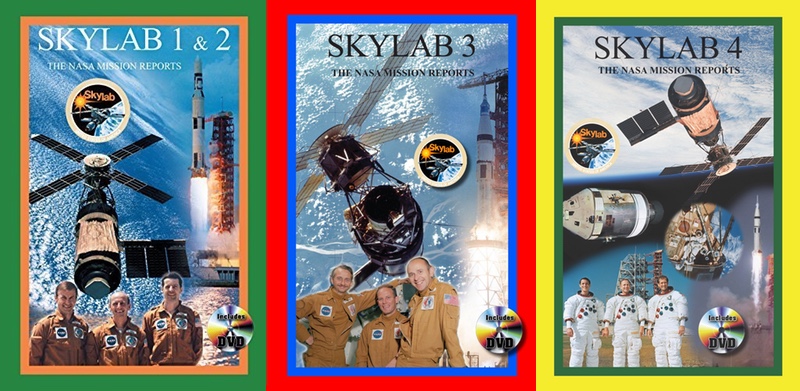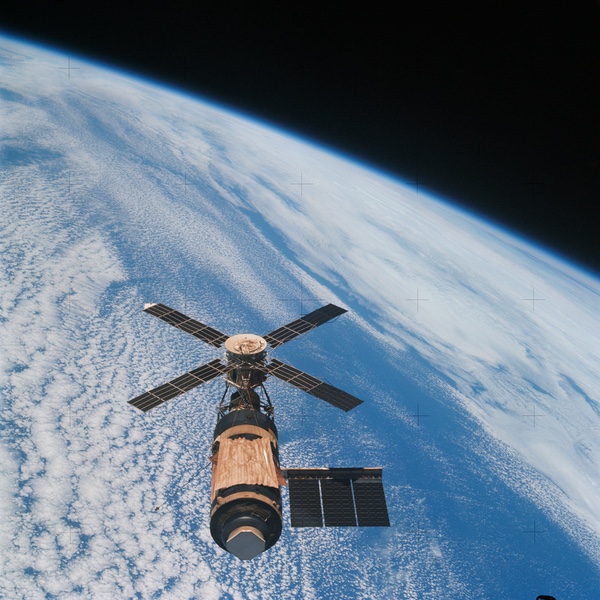Outpost in the Sky: Skylab, the NASA Mission Reportsby Dwayne Day
|
| Skylab is in some ways a forgotten subject in American space history. |
Skylab had multiple objectives, including life sciences research and Earth and solar observations. Many of these early research programs have had profound but unheralded legacies within their fields. Scientific study of the Sun had existed for a long time, but Skylab injected substantial money into it, funding a suite of instruments and a community of researchers. Space life sciences of course grew out of aerospace medicine, but the long-duration Skylab flights helped to establish research baselines and explore new subjects. But Skylab also was an impressive demonstration of engineering and operations ingenuity, although it was not supposed to be.
Skylab was launched into orbit in May 1973 and suffered damage during launch that almost ended the mission. The first manned mission, Skylab 2, was launched only 11 days later and astronauts Pete Conrad, Joseph Kerwin, and Paul Weitz managed, through heroic effort, to make temporary repairs to the crippled space station and get it operational. That rescue and repair mission was one of the most impressive spacewalking feats of the entire Space Age, but has been virtually forgotten today. The astronauts spent 28 days on the space station, nursing it back to health and beginning the experiments program.
Skylab 3 launched in late July 1973 with astronauts Alan Bean, Owen Garriott, and Jack Lousma. They made further repairs to the station and spent 59 days aboard, conducting a variety of experiments. In November 1973, Skylab 4 launched to the station with astronauts Gerald Carr, Edward Gibson, and William Pogue. They spent 84 days aboard Skylab.
 |
The first book in Apogee’s series, Skylab 1 & 2: The NASA Mission Reports, includes substantial discussion of how and why the workshop was damaged during launch along with illustrations and photos of the damage. When the crippled space station reached orbit, NASA had telemetry about what had happened and attempted to quickly determine the precise nature of the problems. NASA engineers knew that a meteoroid shield had torn off, taking a large solar panel with it. They tried to determine which bolts had sheared, what metal might have twisted and split, and how this affected the interior of the spacecraft. This was important for designing equipment to repair the damage and advising the astronauts on Skylab 2 what they needed to do. Not mentioned is the still-classified story of how the National Reconnaissance Office used a top-secret satellite to photograph the damaged space station to aid in planning the repair mission. Of course, after the astronauts reached the station, they took much better pictures and did their own assessment and that later fed into NASA’s report on the mishap, included in the book.
The crew debrief section at the back of the book is over 100 pages covering everything from science experiments and equipment, to exercise, to the food the astronauts ate. The astronauts reported eating less in orbit, but believed it was mostly because the food was barely edible rather than because their appetites were suppressed in a weightless environment.
| Perhaps the most interesting aspect of the crew debriefing is how their comments indicated that NASA’s astronaut corps was changing. |
Skylab 3: The NASA Mission Reports covers the second manned mission. The crew also performed repairs on the station, but were able to devote more time on their much longer mission to performing scientific experiments. The crew debrief at the end of the book is 150 pages long with smaller text, but like the first book includes margin labels so the reader can find subjects of interest.
Skylab 4: The NASA Mission Reports devotes almost half of the book—200 pages—to the crew debrief. The level of detail in all three crew debriefs is quite high, which is likely to tax even the most hardy reader. However, there are odd and fascinating details to be found. For instance, during reentry in February 1974 the crew noticed that the pinkish plasma that formed around their spacecraft was not uniform but seemed concentrated in streaks, which concerned them because it indicated that the heat shield was not ablating equally. Although the Apollo program was mostly over, there was one more flight of an Apollo spacecraft planned.
But perhaps the most interesting aspect of the crew debriefing is how their comments indicated that NASA’s astronaut corps was changing. Skylab 4 was the first all rookie crew; the earlier crews were headed by Apollo moonwalkers. But the Skylab 4 crew of astronauts Carr, Gibson, and Pogue recognized that the astronaut job description was evolving. They were in space to do experiments, not to fly the spacecraft.
Like many other books published by Apogee, these three each come with a DVD. The first DVD includes low-quality video of press interviews and the launch of both the workshop and Skylab 2. The second DVD includes a NASA “Skylab 3” documentary and launch footage. But this DVD includes perhaps the most interesting feature: a digital reconstruction of the workshop interior and a fly-through showing all the key equipment and experiments and other components. I kept wishing that the image was interactive and that I could stop and examine the equipment in greater detail.
The final DVD includes launch footage, a status report, a couple of Skylab documentaries, NASA audio reports on the workshop’s 1979 reentry, and a lengthy inflight press conference by the astronauts (actually comprising several appearances by the crew.) Although the press conference is not incredibly engaging, it does provide some interesting insights into the crew’s psychology as well as the development of long-duration space operations. For example, at one point one of the astronauts discusses how rushing to complete as many tasks on the checklist as possible is not a good way to work. What they need is time between tasks to pause and think about what they did and recalibrate before continuing. Notably, the Skylab 4 crew engaged in what became known as the “Skylab mutiny” on December 28, 1973, when they shut off communications with the ground for a day. One of the contributing factors may have been that the crew was driven at the same hard pace as the previous crew, but for a longer period of time.
NASA later operated the shuttle where crews often performed experiments, sometimes around the clock, but for much shorter periods of time. It was not until the International Space Station reached a more occupied status in the 2000s when NASA once again approached some of the same levels of activity as encountered on Skylab. ISS crews reported being very busy, but of course NASA had learned a lot more since Skylab about proper rest periods, workloads, and the differences in personalities and levels of training. There were no longer any “mutinies” in space.
| It may be a largely forgotten chapter in early American spaceflight history, but its scientific legacy lives on, and these books from Apogee provide a detailed insight into the missions that flew to Skylab over four decades ago. |
NASA built a fully flight-qualified backup workshop. For a while, NASA considered modifying it to include a powerful telescope for astrophysics research. For a brief period of time in the early 1970s the agency evaluated launching it as-is, possibly putting it in dormant status until the space shuttle became operational in the late 1970s. Even this would have required modifications, because the shuttle and Skylab operated with different atmospheres. The biggest problem was simply money: NASA needed to retire the Saturn V and Apollo hardware, including the support facilities such as launch pads needed for the shuttle, at the earliest opportunity. The best way to make the Skylab backup available for shuttle would be to delay its launch as long as possible, but that would have been costly and interfered with the shuttle schedule, like constantly kicking a ball that you want to pick up. Skylab also was not designed to stay in orbit unoccupied for many years.
But there was another problem as well: NASA didn’t really have clear human spaceflight plans beyond getting the shuttle operational. NASA officials did not want to simply repeat the earlier Skylab missions, or fly more crews for longer durations. There was no human Mars mission in the works that could have used data about long-duration human spaceflight. The Skylab backup workshop was the wrong focus for the agency, and provided too much capability for the agency’s plans for the first few years of shuttle operations. By the early 1970s, NASA was no longer interested in biomedical research for long-duration spaceflight, and the Skylab backup would have required substantial redesign to give it additional tasks. Skylab simply did not fit into NASA’s future.
NASA donated the backup workshop to the Smithsonian and returned the solar instruments to their scientists, most of them at universities. In the past year, many of those instruments, which were eventually donated to the Smithsonian by their scientist owners, have gone on display at the Udvar-Hazy Museum near Dulles International Airport.
It is unlikely that Apogee will produce another Skylab book, but if they do, a good subject would be the various studies of Skylab backup missions, as well as the studies of using the space shuttle to visit, refurbish, or reboost Skylab, and Thomas Frieling’s excellent Quest article about the decision to not fly the backup workshop. Skylab eventually fell to Earth, splattering over Australia on July 11, 1979. It may be a largely forgotten chapter in early American spaceflight history, but its scientific legacy lives on, and these books from Apogee provide a detailed insight into the missions that flew to Skylab over four decades ago.
